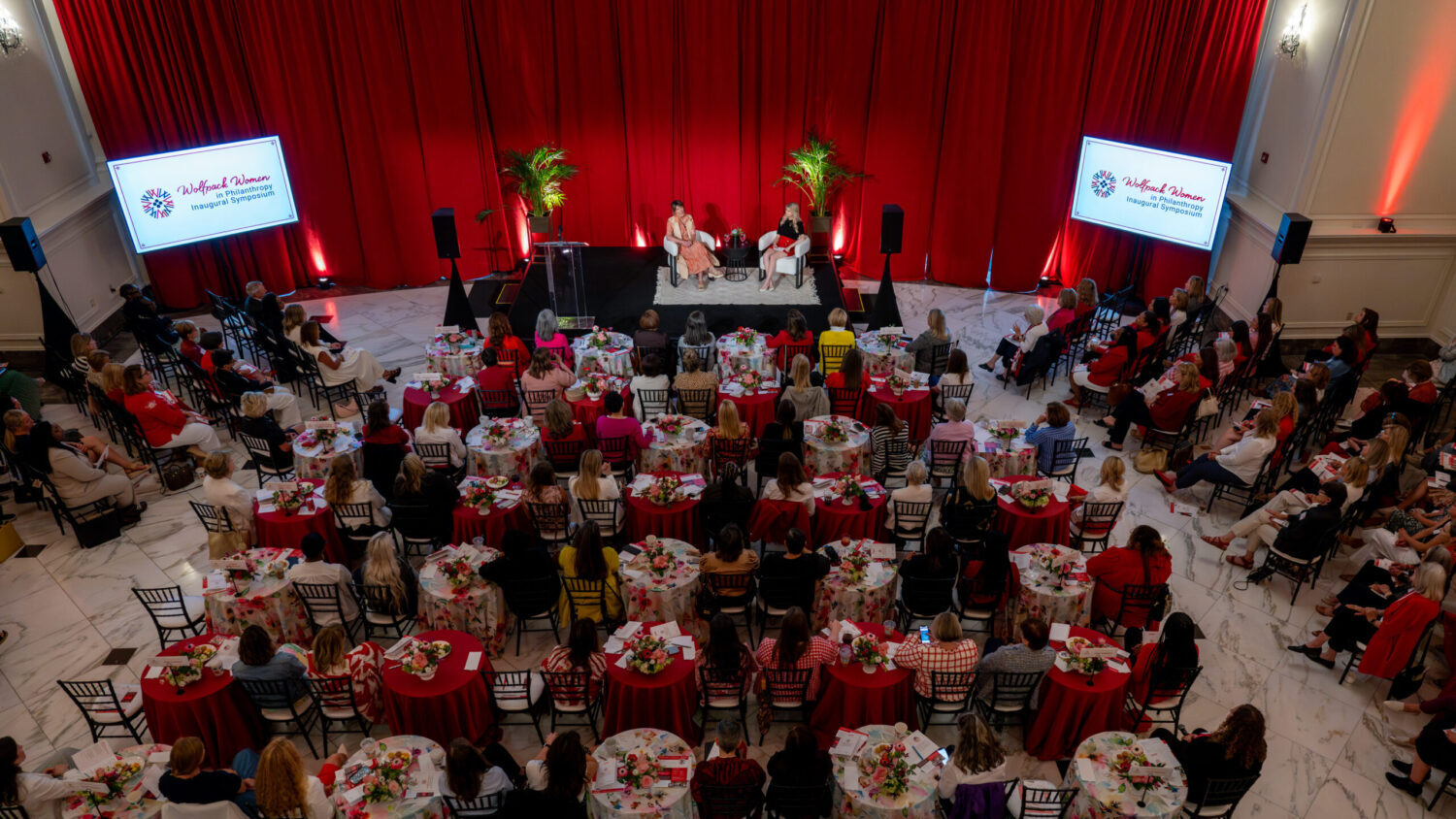Gels and Liquids and Poultices, Oh My: How the Belltower Got a Little Brighter
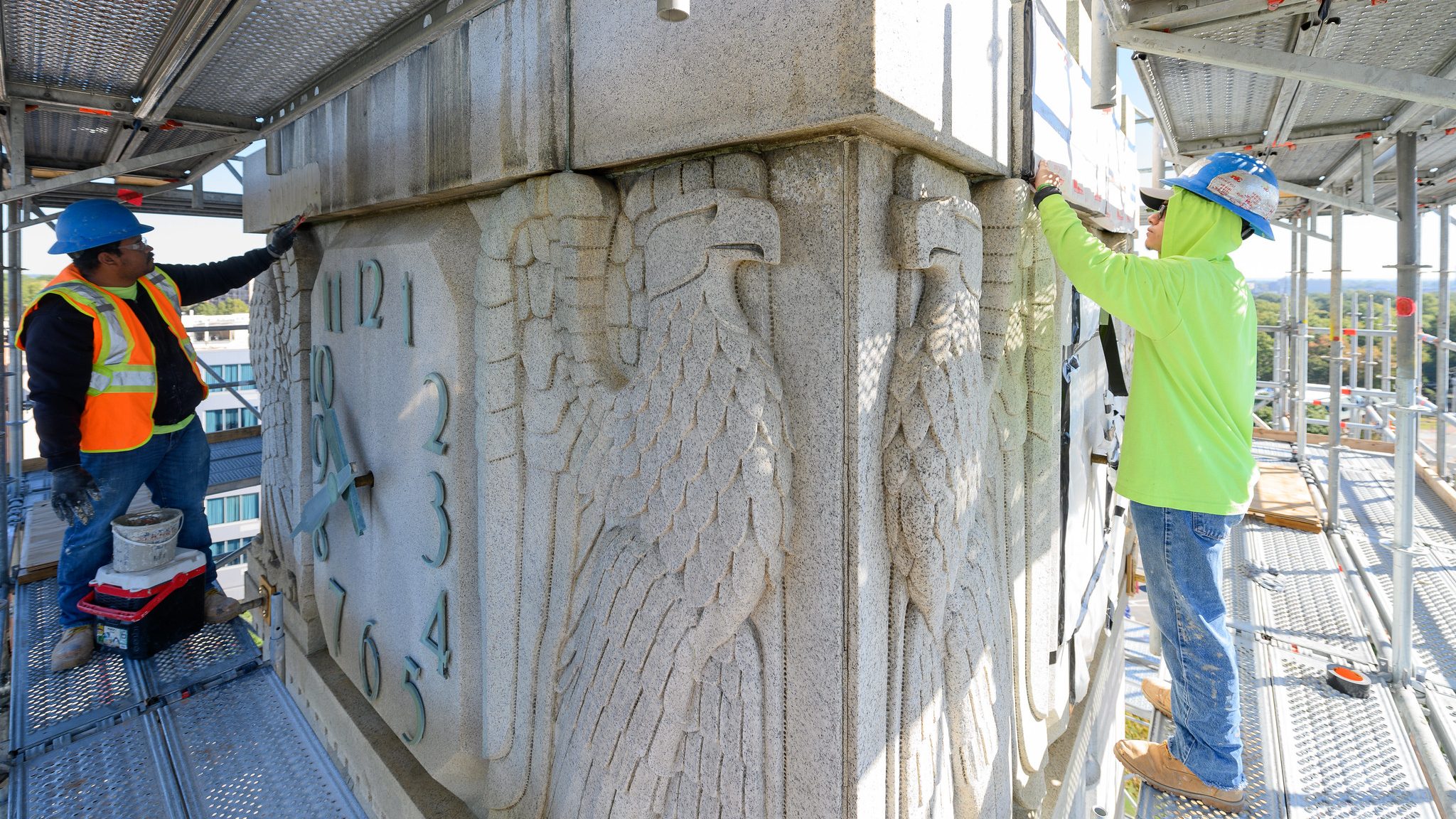
This story is part of an ongoing series highlighting the restoration and completion of the Memorial Belltower. Click the link to learn more about the history of NC State’s Legend in Stone.
As NC State’s fall semester draws to a close, so too does the first phase of its Memorial Belltower restoration and completion project.
On a blustery Tuesday during the first week of December, workers started taking down the expansive scaffolding built around the tower in the late August and early September heat. The scaffolding disassembly — and this past weekend’s re-emergence of the Belltower that had been temporarily hidden behind it — signaled the end of the exterior cleaning and restoration that has taken place over the past few months.
A multistep process has pulled out and removed dirt and impurities, leaving a visibly brighter, more radiant surface.
In simple terms, the university’s iconic structure got a facial.
But the cleaning and restoration — which included tasks like repointing failing mortar joints — is about more than skin-deep beauty.
“Ongoing deterioration was an issue,” said project manager and historic preservationist Michelle Portman of the Belltower project team’s Walter Robbs Callahan & Pierce Architects. “The marble and serpentine within the Shrine Room, including the memorial tablet, are in very poor condition due to water infiltration into the tower, which was exacerbated 10 years ago by the application of a sealer to the exterior of the tower. The marble walls were ‘face spalling,’ or literally falling off in chunks into the room.
“Removing the sealer and stopping the water infiltration into the tower are very important elements of the project. The building has been through a lot.”
Exterior cleaning and restoration was step one in the project, which is expected to be finished in late 2020 or early 2021. The highlight will be the installation of a 55-bell carillon to finally complete the Belltower, which was initiated a century ago as a memorial to NC State alumni who lost their lives serving in the U.S. military during World War I. The plaza surrounding the tower will be renamed Henry Square to honor a lead gift supporting the work from Bill (’81) and Frances Henry as part of the Think and Do the Extraordinary Campaign.
This cleaning was the piece of the plan most subject to being hampered and slowed by wet weather and temperatures below 40 degrees, due to the various gels, liquids and poultices involved. It was completed successfully before extended cold weather set in.
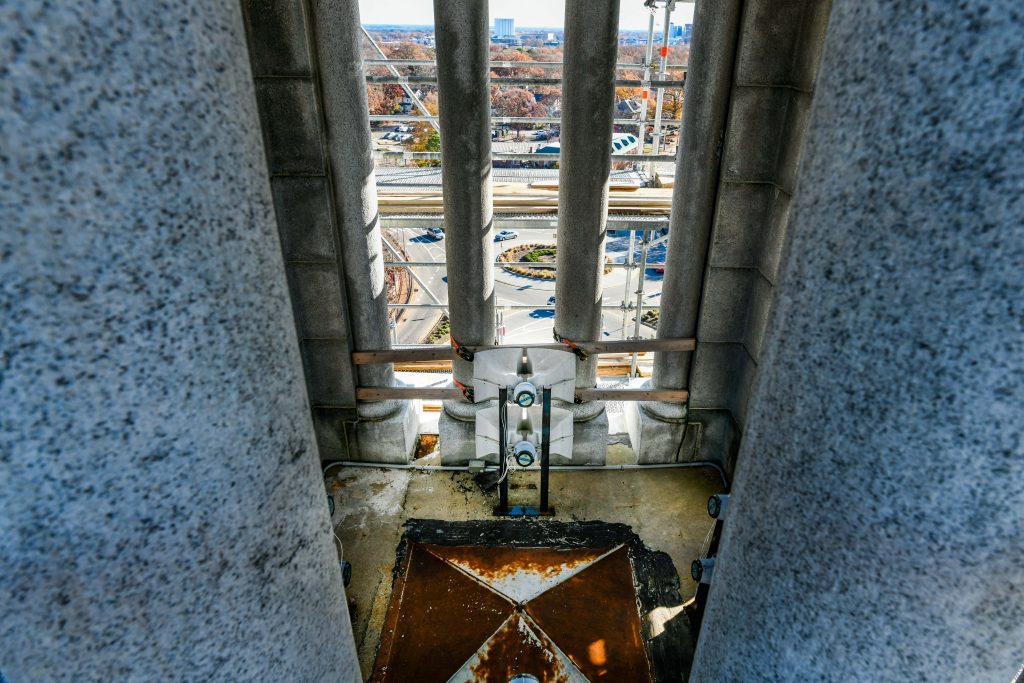
The scaffolding also came down just in time to allow NC State students graduating this month and others to place their class rings in the Shrine Room overnight. This afternoon, Tom Stafford, retired vice chancellor for student affairs, is leading the ring ceremony as he has for the past 15 years, in conjunction with the Alumni Association. Though ceremonial aspects will shift to the lawn of Holladay Hall, students will be able to walk carefully inside the perimeter fence, onto what remains a construction site (although one without activity for the afternoon), to set their ring boxes inside the tower.
A different arrangement of scaffolding is likely to appear at the Belltower site in a few months for later phases of the project.
A Careful Approach
Starting right after the annual Packapalooza celebration, and up until Thanksgiving break, crew members in bright safety vests and hardhats moved steadily up and down the metal stairs and walkways surrounding (but not attached to) the entire 115-foot-tall tower. They labored in the midst of what looked like a giant Erector set crossed with a huge Jenga game — a Jenga game a bit taller than an 11-story building.
At times, the hum of pressure washers signaled their work was ongoing. Much of the cleaning, however, relied on wooden and plastic hand tools such as chisels, trowels, putty knives, brushes, spatulas and even ice scrapers.
Several methods removed organic and inorganic staining that had collected on the Belltower over the decades.
The lower half of the tower, for example, had a bit of a mottled appearance because of salt crystallization in the historic masonry — “historic” defined in the fields of architecture and construction as a building or material more than 50 years old. In addition, salts migrating through the mortar had collected at the exterior face of the tower walls in the form of efflorescence blooms. These blooms were symptomatic of processes going on within the walls.
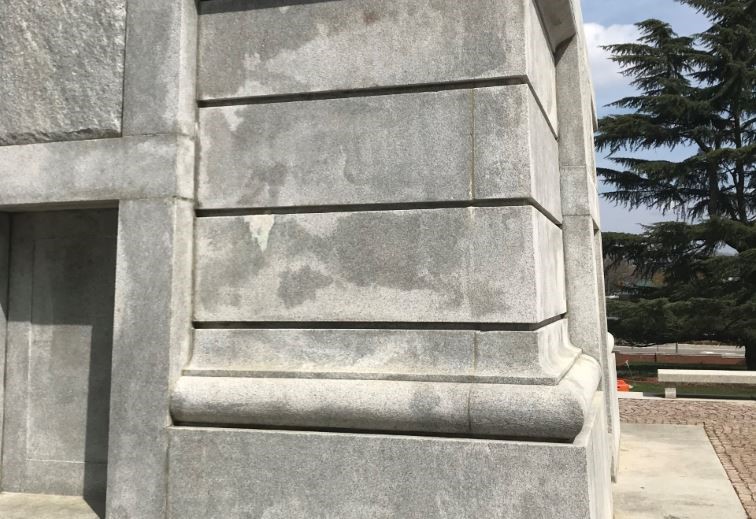
Salt crystallization in building materials is an important cause of deterioration in historic structures around the world.
Salts are ionic compounds that can be naturally occurring or result from everything from environmental pollutants to the very mortar used in the structure. They can be transported to and across a structure by way of groundwater, rain, splashing during the deicing of nearby roads and many other ways; climate and temperature play a role in their behavior.
These salts are soluble and can dissolve and recrystallize within stone pores, which eventually breaks down masonry and causes surface corrosion, flaking, blistering and the like.
“Ideally, these salts move through the mortar joints, specifically the pointing mortar, not the stone. Pointing mortar is a sacrificial material intended to fail, so the stone does not, and be replaced on a cyclical basis,” Portman said.
The Belltower’s cleaning was carefully prescribed, with everything from pH values to water flow levels and the size of fan spray tips on the masonry washing equipment specified (and spot-tested) ahead of time. Clock hands and numbers had to be masked during the cleaning. Cleaning agents could only be applied by hand.
Five Stages of Cleaning
Workers used a gel cleaner, brushed into every joint and crevice, to strip off that waterproofing sealer that had been applied in an unsuccessful attempt to slow water infiltration into the tower. Once a common response to interior water damage, the sealer actually trapped moisture in the unventilated tower and increased damage to the marble in the Shrine Room.
The final step was a full washing with a restoration cleaner.
In between: three stages of removing efflorescence crust, carbon, biological, ferrous and cupric stains from the granite both manually and with varying poultices targeted at types of stains. A poultice is a special absorbent material that draws out contaminants from below the surface — similar to a clay mask.
Workers applied poultice in a quarter-inch thickness in sections, between straight edges or joints, then covered each section with a paper film for about 24 hours. They removed each covering, let that poultice dry for two to four hours until it began cracking, scraped and brushed off the residue, then repeated the process a second time with each poultice, moving section by section.
Cleaning began from the bottom of the tower and moved upward, which seems counterintuitive. But some cleaners must be applied to a dry surface, so workers would scrub, rinse, then go up to the next level while ensuring that dirty residue and rinse water did not wash over cleaned surfaces.
Much of the ferrous (iron) staining was located below the tower’s eight open windows, their frames and screens. The cupric (bronze and copper) staining largely resulted from the aging of the copper roof.
After cleaning, workers completed repointing in any spot where mortar had been loosened or was missing.
The project team was careful to be just aggressive enough with the cleaning to avoid altering the historic integrity of the structure. Their approach: The Belltower has proudly earned its scars and wisdom; it shouldn’t appear brand new. And its appearance, after all, reflects the twists, turns and delays in its construction and funding in those early years.
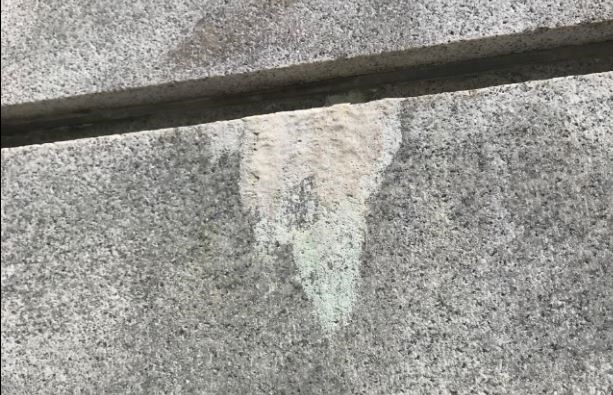
The 1921 portion, Portman explained, was built with “6-cut textured granite with rubble granite backup; the 1925 portion, with 6-cut textured granite with board-formed concrete backup; and the 1937 portion, with solid 4-cut textured granite, no backup.”
“The fact that the building sat uncovered from 1925 to 1937 is a significant issue,” she said.
Water infiltration into the top of the then-unfinished and uncovered masonry walls resulted in migration of salts from the rubble backup through the face of the exterior granite, a primary factor in the lower half of the tower looking different from the upper half.
“You will still be able to see the demarcation between the 1925 and 1937 portions of the tower, but now the two parts will blend slightly better,” Portman said. “There was a very fine line between not cleaning enough and cleaning too much. To accomplish the ‘most with the minimum,’ we specified the five types of cleaning.”
The Shrine Room and its marble, serpentine and granite will be restored in an upcoming phase of work.
Some work at the site over the next few weeks will be less visible before heavier construction begins in the spring. The project includes creation of an ascending path, or raised walkway, at the south side of the plinth to improve accessibility; lighting, security and electrical upgrades; a new drainage system; installation of heating, ventilation and air conditioning; and more.
And of course, that “more” includes the bells that are coming in a few months, along with a new playing cabin to be built just below the clock level and a winding interior stairway to get there.
- Categories:

